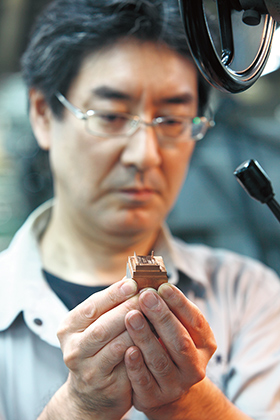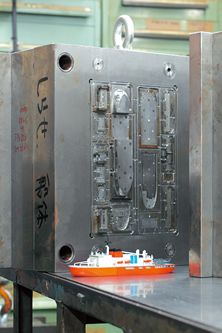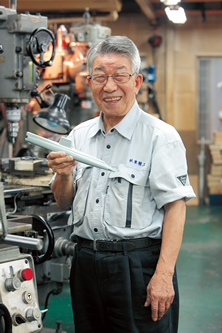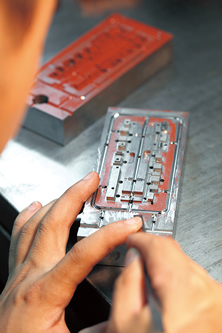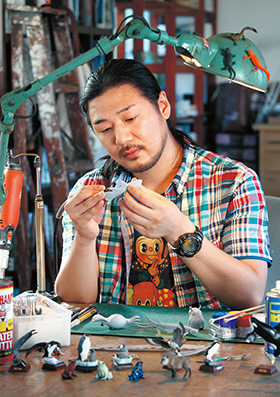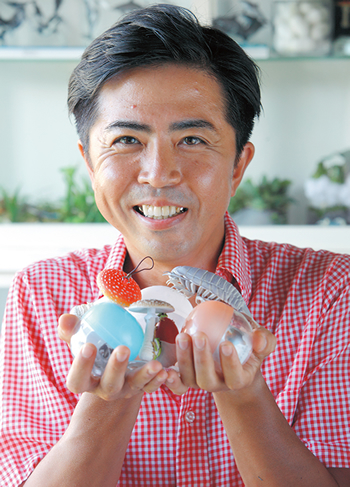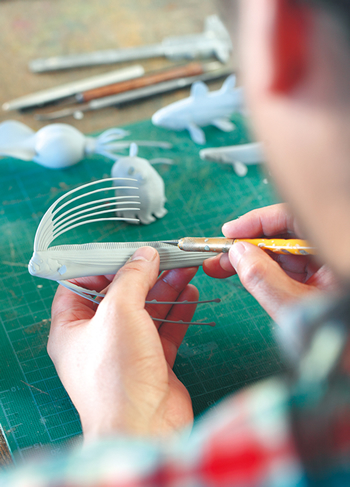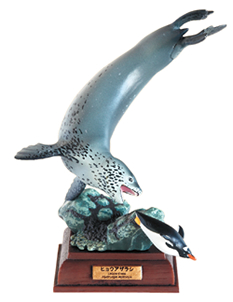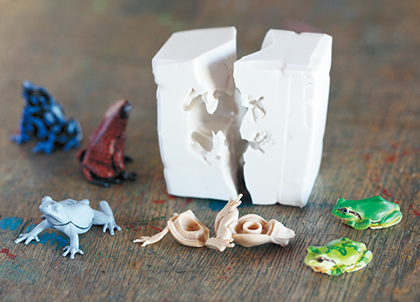niponica is a web magazine that introduces modern Japan to people all over the world.
2015 No.17
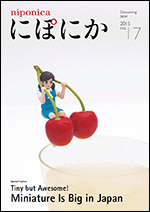
To read the e-book you need to have JavaScript enabled in your browser and a free Flash Player plug-in from Adobe Systems Inc. installed.
Miniature Is Big in Japan

More Than Just Toys
Animé characters, vehicles, animals, works of art... These are just some of the tremendous array of made-in-Japan scale models that are always popular for their diversity and high quality. Join us for a tour of two factories and discover some of the secrets behind precision model manufacturing.
Photos: Natori Kazuhisa
Craftsmanship in a small factory brings realism to plastic scale models
Molten plastic is injected into metal molds to make scale-model parts. One of the mold manufacturers is Syuto Inc. It was established in 1978 and operates in downtown Edogawa City, Tokyo.
The molds for parts of a plastic model are each assembled from several parts to make a single mold. Individual parts of the mold can easily end up with a slight distortion or size discrepancy. It is especially difficult to make molds for parts that will be snap-fit without glue.
Syuto excels in precision molds, including molds for models with snap-fit parts. From its small factory have come molds for an impressive array of hit products. The company is a driving force in Japan’s scale model industry, and a shining example of craftsmanship at work.
Company founder and chairman Shibata Mikio was closely involved in the creation of Japan’s first plastic model, which was a model of the nuclear-powered submarine USS Nautilus. “Back then, our tools for making metal molds included cold sets, which are something like chisels. One effort after another ended in failure, but it was amazingly rewarding trying out different techniques until we got it right,” he grins.
Today, after the computer design phase, the factory uses a 3D printer to make samples, and then machinery to cut the metal pieces that will become the molds. Tiny sharp edges that cannot be smoothed down with a cutter are removed through electric melting, leaving the desired smoothly rounded surfaces.
Then finally, human hands take over as artisans use remarkable skill to fine-tune parts to an accuracy of 1/100th of a millimeter. They paint the mold’s joints and place them together to check for surface irregularities, and whittle those irregularities away with an electric sander, using their fingers for confirmation. In addition to touch and other senses, their work is guided by experience. It takes at least five years to become truly skilled at it.
When scale-model parts are made from high-precision molds, no burrs remain on the final product, showing how smooth the joints of the mold were made. The trick to making products without burrs is simply for everyone involved in the mold-making process to be vigilant about avoiding them. Setting high goals and finding ways to reach them seems to be essential in precision manufacturing.
Shibata Mikio holding the first made-in-Japan scale model of the nuclear powered submarine USS Nautilus. He was personally involved in the project that produced the model.
Life in miniature, inside a capsule
Supermarkets and video game centers are some of the places where you can easily find capsule toys dispensed from vending machines. Inside the capsules are tiny figurines, their popularity as strong as ever. Their history in Japan goes back to the 1960s, when they were first imported along with gumball machines from the United States. Back then, they could be bought cheaply, for around 10 yen each. Since the 1970s the range of items has evolved to include things like figurines and erasers of animé characters. Today, one capsule goes for around 300 yen.
The “Japanese Frogs” and “Antarctica” series are just two of the many items created by the company Ikimon, which specializes in capsule figurines of natural living things. Its products come in series of six to eight items in capsules 40 to 75 mm in diameter, and they are often ready to expand through assembly or folding.
Bringing life to figurines is difficult, so the creators at Ikimon never compromise on the design elements, such as the curvature of the neck and the expression of the eyes. Color is also important. The company generally needs from six to eight months, and sometimes almost two years, to take an item from the planning stage to a finished product.
The figurine molds are made by cast creators. They shape the resin with an electric grinding machine, and develop the form with handmade tools made of materials such as wood and thin brass wire. “There’s no right way to make the original form, no set procedure. Everyone here uses their own method, and develops their own tools for the job at hand,” says Terasawa Ko. His career in the field goes back 15 years.
If things go smoothly, a six-item series can be finished in a month, but if doubts arise, it might take more than a year.
“When something isn’t right, it seems odd right away. At first I don’t know why I get that feeling—maybe the arm contours, or the pose; I just know I have to change certain details, and then others. That is why it can really take time.”
The figurines may be cheap and easy to buy, but customers still want a high degree of perfection. The creators who deliver it have brought renown to Japan’s scale model culture through hard work and self-discipline.
Japanese scale models have a quality that depends highly on subjective senses such as impressions and touch. They exude a special friendliness. Perhaps because of their vibrant, lifelike nature, they seem to take people—young or old, male or female—into a world of fantasy.





